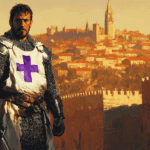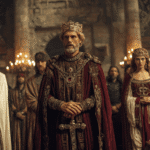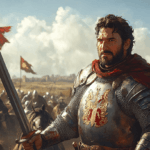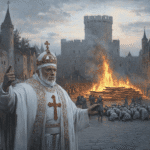
Introduction: Iberia in the 11th–12th Century
The Iberian Peninsula in the early twelfth century was not yet “Spain.” Instead, it was a patchwork of Christian and Muslim polities, whose frontiers were fluid, violent, and constantly redrawn. In the north, Christian kingdoms like León, Castile, Navarre, Aragon, and Portugal all pursued their own ambitions, often as much against each other as against the Muslim states to the south.
The story of Aragon and Castile in the eleventh century is one of competition as much as alliance. At stake was control of frontier lands, prestige in the Christian struggle against Islam, and, ultimately, mastery of Iberia.

The Rise of Aragon
Aragon in 1100 was a small, mountainous kingdom tucked into the Pyrenees. It had emerged as an independent polity in the ninth and tenth centuries, a frontier county grown into a kingdom. Its fortunes were transformed by Sancho Ramírez (r. 1063–1094) and his son Peter I (r. 1094–1104), who pushed southwards against Muslim-held Huesca and Barbastro. But the true architect of Aragon’s rise was Alfonso I “the Battler” (r. 1104–1134).
Alfonso was a warrior king of rare energy. He captured Zaragoza in 1118, a prize of enormous symbolic and strategic value: it had been the capital of a taifa and stood as the great Muslim bastion of the Ebro valley. With Zaragoza, Aragon suddenly became a serious player in Iberian politics. Alfonso’s restless campaigns brought him deep into Muslim lands, and he cultivated ties with the Knights Templar and other military orders, foreshadowing the increasingly crusading character of Iberian warfare.
But Alfonso’s ambitions also brought him into conflict with his Christian neighbors, especially Castile. His marriage to Urraca of León-Castile in 1109, intended to unite the two realms, collapsed in acrimony. The union failed both personally and politically, leading to years of civil war across Castile and León, with Aragonese forces deeply entangled.
Castile and León in the Early 12th Century
By contrast, Castile was the larger and richer kingdom, though politically unstable. At the dawn of the century it was ruled as part of the broader Leónese realm under Alfonso VI, the great conqueror of Toledo in 1085. But Alfonso VI’s death in 1109 unleashed turmoil. His only surviving legitimate heir was his daughter Urraca, who became queen of León and Castile. Her ill-fated marriage to Alfonso I of Aragon brought not union but war, as nobles on both sides resisted domination by the other kingdom.
The civil strife that followed saw shifting alliances: some Castilian nobles backed Alfonso the Battler, while others remained loyal to Urraca. Even after their separation, conflicts between Aragon and Castile flared intermittently, particularly over frontier zones in Rioja and Navarre. It was in this turbulent context that Urraca’s son by her first marriage, the future Alfonso VII of León and Castile, came of age.
Alfonso VII: “Emperor of All Spain”
In 1126, with Urraca’s death, her son Alfonso VII ascended to the throne of León and Castile. His reign (1126–1157) marked a turning point. Alfonso sought to restore the authority of the crown, expand southwards against Islam, and assert a grandiose supremacy over his fellow Christian rulers. In 1135 he was crowned “Emperor of All Spain” at León, reviving the old Leonese imperial idea that the ruler of León-Castile held seniority over all other Iberian kings.

For Aragon, this was a provocation. Alfonso I the Battler refused to acknowledge any imperial overlordship. Instead, he pressed his own campaigns, not only in Muslim territory but even into Provence across the Pyrenees. The rivalry was sharpened by geography: the Rioja region, Navarre, and the upper Ebro valley formed a contested borderland where Aragonese and Castilian forces frequently clashed.
The Crisis of 1134: Death of Alfonso the Battler
The fragile balance between Castile and Aragon was upended by the sudden death of Alfonso I the Battler in 1134, during a campaign against the Muslims at Fraga. His will shocked contemporaries: he bequeathed his kingdom not to an heir, but to the military orders: the Templars, Hospitallers, and the Church of the Holy Sepulchre.
This bizarre testament was unacceptable to Aragonese nobles, who swiftly rejected it. Instead, they elected Alfonso’s brother Ramiro II, a monk, as king. Ramiro, unworldly and reluctant, agreed only to serve temporarily. His task was to safeguard the succession until a suitable arrangement could be made. The solution was a dynastic marriage: Ramiro’s infant daughter Petronilla was betrothed in 1137 to Raymond Berengar IV, the Count of Barcelona. With this act, the Crown of Aragon was born – not yet a unitary state, but a dynastic union of Aragon and Catalonia that would transform the balance of power in Iberia.
Castile vs. the New Aragonese-Catalan Power
The union of Aragon and Barcelona gave the eastern kingdom new strength. The Catalans brought wealth from Mediterranean trade, maritime connections, and a foothold in Provence. Raymond Berengar IV proved an energetic and capable ruler, consolidating his hold over both Aragonese and Catalan lands while pushing southwards against the Muslim taifa of Valencia.
This new Aragon-Catalan power inevitably collided with Alfonso VII’s ambitions. The two monarchs were bound to negotiate the division of spoils in the Reconquista. Both eyed the rich territories of Al-Andalus, particularly Valencia, Murcia, and Andalusia. But they also feared open conflict with one another while the Almoravids still held strong in the south. Thus diplomacy as well as war became necessary.
Toward Tudilén: Early Encounters
During the 1140s, Alfonso VII and Raymond Berengar IV tested each other’s strength along their borders. Tensions centered on Navarre, which had broken free as an independent kingdom after Alfonso the Battler’s death. Both Castile and Aragon sought to dominate it.
Yet both rulers also cooperated when convenient. In 1147, Alfonso VII launched a great offensive southwards, capturing Almería with Genoese naval support. Raymond Berengar IV, meanwhile, focused on pushing into the Ebro valley and Valencia. The parallel campaigns highlighted their overlapping interests — and the danger of stepping on one another’s toes.
To prevent outright conflict, negotiations began. The result would be the Treaty of Tudilén (or Tudején), signed in 1151, a landmark attempt to divide the Iberian spoils.
The Treaty of Tudilén (1151)
The Treaty of Tudilén was concluded between Alfonso VII of León-Castile and Raymond Berengar IV of Aragon-Barcelona at Tudilén, near Soria. Its purpose was to draw a line of demarcation in the Reconquista, allocating spheres of conquest to each power.
- Aragon’s sphere: Valencia, Denia, and Murcia – the Levantine coast and the southeastern peninsula. These territories, geographically closer to Catalonia, would provide outlets to the Mediterranean.
- Castile’s sphere: Andalusia – Córdoba, Seville, and Jaén – the great heartlands of the Guadalquivir valley. This reflected Castile’s orientation toward the central and western south.
The treaty also confirmed Castile’s recognition of the new Crown of Aragon, born from the Petronilla–Raymond Berengar marriage. In exchange, Aragon acknowledged Alfonso VII’s imperial dignity.
In theory, Tudilén provided a neat division of labor in the Reconquista. In practice, it was more of a diplomatic framework than a binding pact. Both kingdoms would soon stretch, bend, or ignore its terms when opportunity beckoned. Still, it marked a crucial moment: an acknowledgment that Aragon and Castile, though rivals, had to coexist and coordinate in carving up Muslim Iberia.

Aftermath and Significance
The Treaty of Tudilén set the stage for the next phase of Iberian politics. Alfonso VII died in 1157, dividing his realm between his sons: Sancho III received Castile, and Ferdinand II received León. This weakened the imperial idea and gave Aragon greater room to maneuver.
Raymond Berengar IV died in 1162, leaving the crown to his young son Alfonso II of Aragon, who would continue to press southwards into Valencia and north into Provence. Meanwhile, Castile under Sancho III and his son Alfonso VIII turned increasingly toward the challenge of the Almohads in the west and south.
The Treaty of Tudilén did not prevent clashes between Castile and Aragon, but it reflected a dawning recognition that both kingdoms were locked in a long game: not only against Islam, but against each other. By attempting to codify spheres of influence, they foreshadowed the later partition treaties that would recur throughout the Reconquista – culminating centuries later in the eventual union of the crowns under Ferdinand and Isabella.
Conclusion
The fifty years before the Treaty of Tudilén in 1151 was transformative for Iberia. Aragon rose from a Pyrenean backwater to a Mediterranean power through the bold conquests of Alfonso the Battler and the dynastic union with Barcelona. Castile, though wracked by civil strife in the early decades, reasserted itself under Alfonso VII, who dreamed of imperial authority over all Spain. Their paths crossed and collided, sometimes in marriage, sometimes in war, and finally in diplomacy at Tudilén.
The treaty was less a lasting settlement than a snapshot of ambitions at mid-century: Castile gazing toward the Guadalquivir, Aragon stretching toward Valencia and the Levant. The struggle between these two powers would shape Iberia for centuries to come, until their eventual fusion created the foundation of modern Spain.




